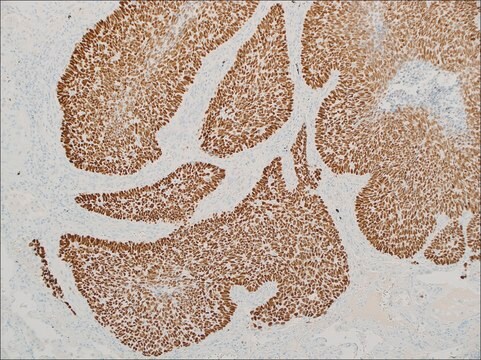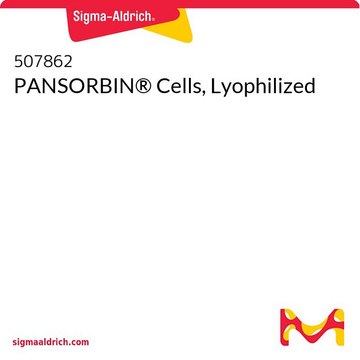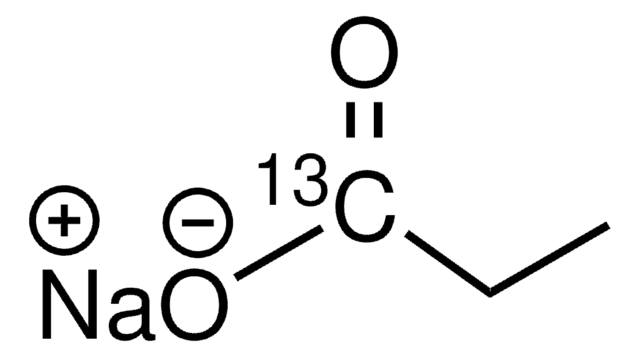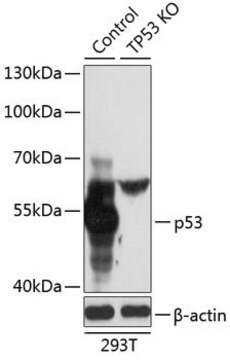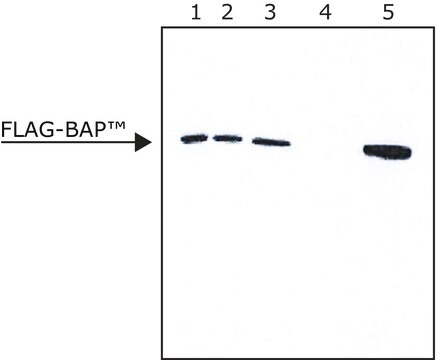507858
PANSORBIN® Cells
Synonim(y):
Staphylococcus aureus Cells
Zaloguj sięWyświetlanie cen organizacyjnych i kontraktowych
About This Item
Kod UNSPSC:
41116133
NACRES:
NA.42
Polecane produkty
Postać
suspension (Homogeneous)
Poziom jakości
producent / nazwa handlowa
Calbiochem®
warunki przechowywania
do not freeze
zanieczyszczenia
≤2500 cells/mL Viable cells
kolor
milky
pojemność
≥2.0 mg(human IgG/100 mg cells)
Warunki transportu
ambient
temp. przechowywania
2-8°C
Opis ogólny
PANSORBIN Cells are heat-killed, formalin-fixed Staphylococcus aureus cells that have a coat of protein A and have been pickled by the method of Kessler. Useful for mitogenic stimulation of B lyphocytes and for immunoprecipitation.
Heat-killed, formalin-fixed Staphylococcus aureus cells (Cowan I strain) that bear a high cell-surface density of protein A and have been pickled by the method of Kessler. Useful as a solid-phase IgG-binding reagent due to the high affinity interaction of protein A with the Fc domain of IgG. PANSORBIN cells work best when the antibody is human (IgG1, IgG2, IgG4), rabbit IgG (all isotypes), or mouse (IgG2a, IgG2b, IgG3). Most common applications include immunoprecipitation and mitogenic stimulation of B lymphocytes.
Ostrzeżenie
Toxicity: Standard Handling (A)
Postać fizyczna
Supplied as a 10% suspension of Staphylococcus aureus cells in PBS, 0.1% NaN₃, pH 7.2.
Inne uwagi
Kierszenbaum, F., et al. 1991. Immunology74, 317.
Meikle, P.J., et al. 1991. J. Biol. Chem.266, 22569.
Ezaki, O., et al. 1989. Biochem. Biophys. Res. Commun. 159, 1368.
Murakami, H., et al. 1988. Biochem. J.256, 917.
Kessler, S.W. 1975. J. Immunol. 115, 1617.
Meikle, P.J., et al. 1991. J. Biol. Chem.266, 22569.
Ezaki, O., et al. 1989. Biochem. Biophys. Res. Commun. 159, 1368.
Murakami, H., et al. 1988. Biochem. J.256, 917.
Kessler, S.W. 1975. J. Immunol. 115, 1617.
Informacje prawne
CALBIOCHEM is a registered trademark of Merck KGaA, Darmstadt, Germany
PANSORBIN is a registered trademark of Merck KGaA, Darmstadt, Germany
This page may contain text that has been machine translated.
Hasło ostrzegawcze
Warning
Zwroty wskazujące rodzaj zagrożenia
Zwroty wskazujące środki ostrożności
Klasyfikacja zagrożeń
Acute Tox. 4 Oral
Kod klasy składowania
12 - Non Combustible Liquids
Klasa zagrożenia wodnego (WGK)
WGK 3
Temperatura zapłonu (°F)
Not applicable
Temperatura zapłonu (°C)
Not applicable
Certyfikaty analizy (CoA)
Poszukaj Certyfikaty analizy (CoA), wpisując numer partii/serii produktów. Numery serii i partii można znaleźć na etykiecie produktu po słowach „seria” lub „partia”.
Masz już ten produkt?
Dokumenty związane z niedawno zakupionymi produktami zostały zamieszczone w Bibliotece dokumentów.
Klienci oglądali również te produkty
Leah S Bernstein et al.
Methods in molecular biology (Clifton, N.J.), 237, 195-204 (2003-09-23)
Palmitoylation refers to the covalent attachment of a 16-carbon fatty acid to cysteine residues of proteins. This modification occurs on many intracellular signaling proteins including regulators of G protein signaling proteins (RGS). Palmitoylation mediates the interaction of proteins with membranes
T A Bunch et al.
Nucleic acids research, 17(23), 9761-9782 (1989-12-11)
Genes producing antisense RNA are becoming important tools for the selective inhibition of gene expression. Experiments in different biological systems, targeting different mRNAs have yielded diverse results with respect to the success of the technique and its mechanism of action.
J R Faust et al.
Proceedings of the National Academy of Sciences of the United States of America, 79(17), 5205-5209 (1982-09-01)
UT-1 cells are a clone of Chinese hamster ovary cells that were selected to grow in the presence of compactin, a competitive inhibitor of 3-hydroxy-3-methylglutaryl-coenzyme A reductase [mevalonate: NADP+ oxidoreductase (CoA-acylating), EC 1.1.1.34]. These cells have 100- to 1,000-fold more
Derek Walsh et al.
Genes & development, 20(4), 461-472 (2006-02-17)
Recruitment of the 40S ribosome to the 5' end of a eukaryotic mRNA requires assembly of translation initiation factors eIF4E, the cap-binding protein, together with eIF4A and eIF4G into a complex termed eIF4F. While the translational repressor 4E-BP1 regulates binding
M Achison et al.
The Journal of biological chemistry, 276(5), 3167-3174 (2000-12-09)
Collagen fibers or a glycoprotein VI-specific collagen-related peptide (CRP-XL) stimulated tyrosine phosphorylation of the focal adhesion kinase, p125(fak) (FAK), in human platelets. An integrin alpha(2)beta(1)-specific triple-helical peptide ligand, containing the sequence GFOGER (single-letter nomenclature, O = Hyp) was without effect.
Nasz zespół naukowców ma doświadczenie we wszystkich obszarach badań, w tym w naukach przyrodniczych, materiałoznawstwie, syntezie chemicznej, chromatografii, analityce i wielu innych dziedzinach.
Skontaktuj się z zespołem ds. pomocy technicznej